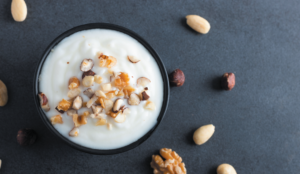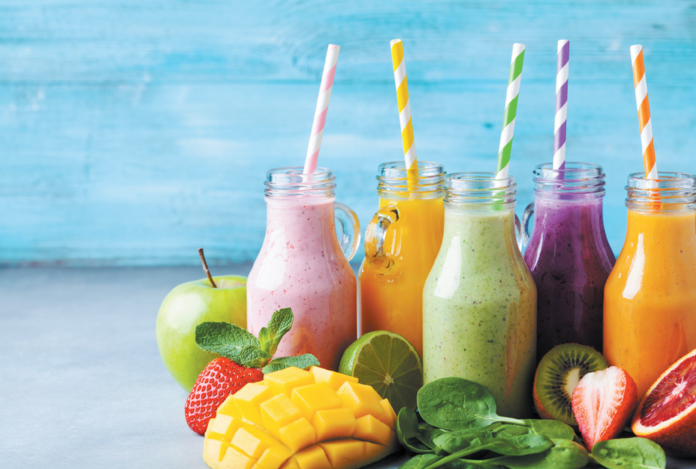For breakfast, snacks, or even meal replacements, smoothies are all the rage. But are they really a healthy choice? That depends on a number of factors, including what is in the smoothie, how much and how quickly you drink it, what it replaces in your diet, and your reasons for drinking it.
1. Ingredients. Some smoothies are healthy blends of fresh or frozen fruits and veggies (carrots and dark leafy greens are popular) puréed with yogurt, milk, or fortified plant milks and perhaps some nut butter or flax seeds. Others are little more than fruit-flavored syrups and ice. The former provide vitamins, minerals, phytochemicals, fiber, and perhaps some protein and healthy fats. The latter provide a lot of added sugars.
Added sugars in drinks have negative health effects, increasing risk for obesity, heart disease, type 2 diabetes, and tooth decay. If you put sugar, honey, agave nectar, or other sweeteners in your homemade smoothie or buy sweetened commercially prepared smoothies, you will be increasing your added sugar intake. The American Heart Association recommends limiting intake of added sugars from all foods and drinks to no more than nine teaspoons (38 grams) a day for men and six teaspoons (25 grams) a day for women and children.Ingredients. Some smoothies are healthy blends of fresh or frozen fruits and veggies (carrots and dark leafy greens are popular) puréed with yogurt, milk, or fortified plant milks and perhaps some nut butter or flax seeds. Others are little more than fruit-flavored syrups and ice. The former provide vitamins, minerals, phytochemicals, fiber, and perhaps some protein and healthy fats. The latter provide a lot of added sugars.
If you enjoy smoothies, follow these tips:
- Upgrade your intake. Make sure smoothies replace less healthful choices.
- Use whole fruit. Whole fruits and veggies are a better choice than juice.
- Avoid added sugars. Check commercial products and don’t add sweeteners at home.
- Add healthy fats and protein. Try plain regular or Greek yogurt, nut butters, and unsweetened cow’s milk or soymilk.
- Sip and moderate. Stick to a reasonable portion size (12 to 16 oz or less) and sip your smoothie.
Natural sugars—found in whole fruits and milk—are not associated with adverse health effects (although individual responses to foods can vary, and people with diabetes may find certain fruits impact their blood sugar levels more than others). When you use fresh or frozen whole fruits in a smoothie, some food structure remains intact, and the final product is not that different from the natural effects of chewing and swallowing whole fruit.
Results of a study measuring the impact of two fruit smoothies on blood sugar showed they did not raise blood sugar levels quickly. The authors concluded that dietary fiber was still present in the smoothies after processing and suggested this fiber likely keeps the sugars from being too quickly absorbed into the bloodstream.
Many commercial smoothies are made with juice rather than whole fruits. In even 100% fruit juice, most of the fiber has been removed and the food structure is no longer intact, so the sugars are free in the liquid. Recent evidence suggests these “free sugars” are similar to added sugars in influencing blood pressure, blood cholesterol, and triglyceride levels, and that reducing intake may lower risk for cardiovascular disease. The World Health Organization (WHO) recommends limiting free sugars to less than 10 percent of calories, and less than five percent is even better for health.
Like fiber, healthy fats and protein can also slow digestion and absorption and increase the overall healthfulness of a smoothie. Including sources of these nutrients is especially important if the smoothie is being used as a meal. Minimally processed real foods (like natural nut butters, plain regular or Greek yogurt, and milk or unsweetened soymilk) are the best choices, as opposed to protein powders.
2. Size and Speed. With all foods, how much and how quickly you eat makes a difference. But this is particularly true for liquids. We can swallow a smoothie more quickly than we could eat all the foods that went into it; and when we eat quickly, we tend to take in more calories than when we eat slowly (see Slow and Steady Wins the Waist on page 3). Without chewing to slow us down, it’s easy to consume more than we need before the “I’m full” signal makes it to the brain.
As far as feeling satisfied, whole foods are better than blenderized: Research shows that an apple is more satiating than applesauce, and applesauce will keep us full longer than apple juice (even juice with added fiber). So, think about how much you put in your glass (aim for 12 to 16 ounces or less), and sip, rather than guzzle, your smoothie over time.
3. Food Swaps. “As with all food swaps, health benefits depend on both what you are eliminating and what you are replacing it with,” says Alice H. Lichtenstein, DSc, senior scientist and director of the Cardiovascular Nutrition Team at the Human Nutrition Research Center on Aging and executive editor of Tufts Health & Nutrition Letter. “Cutting out a high-fiber, low-sugar cereal or bowl of unsweetened oatmeal topped with bananas and walnuts for a premade smoothie with little fruit and lots of added sugars is clearly not a good choice. But a blend of whole fruits and veggies with plain yogurt beats a bowl of sugary cereal or breakfast pastry any day.” Make sure your smoothie is replacing a less-healthful choice.

Image © Foxys_forest_manufacture | Getty Images
4. Personal Goals. People choose smoothies for a variety of reasons. If you enjoy a cold, fruity beverage now and then, these naturally sweet blends are a much better choice, nutritionally, than a strawberry milkshake, juice drink, sweetened nut milk, or energy drink. If you fire up the blender as a way to boost your fruit and veggie intake, keep in mind that starting with whole fruits and vegetables, rather than juice, is best, especially when mixed with other healthy foods containing unsaturated fats and protein.
If you are trying to lose weight, using a smoothie as a meal replacement may or may not be beneficial. The evidence to date indicates replacing breakfast with a smoothie is not a sure-fire way of reducing calorie intake. In a small trial, participants had similar calorie intake throughout the day whether they had cereal with milk or a calorie-matched fruit smoothie at breakfast. But on days they were given a different, high calorie smoothie in the morning, they ended up consuming more calories overall.
“Weight control is about more than counting calories,” says Dariush Mozaffarian, MD, DrPH, dean of the Friedman School and editor-in-chief of Tufts Health & Nutrition Letter. “Food is biologic information that influences many complex, mostly unconscious pathways that regulate our long-term weight.” So, if you stick to healthy, minimally processed ingredients like fruits, veggies, and plain yogurt, milks, and nut butters, the nutrients in that morning drink could help your health and might help your long-term weight control efforts–even if your calorie intake that day doesn’t go down.
Looking at all the evidence, certain smoothies can be part of a healthy dietary pattern. Use whole fruits and veggies and avoid added sweeteners and juice, drink slowly, don’t use more ingredients than you could eat in one sitting, and blend in sources of healthy fats and protein.
























